Friend of the blog Don Schaffner has published some new research that shows the use of antibacterial soaps can reduce the spread of harmful bacteria – that often leads to foodborne illness – more effectively than using non-antibacterial soaps.
The research, published in the peer-reviewed Journal of Food Protection (Vol. 77, No. 4, 2014, pp. 574-582), used new laboratory data, together with simulation techniques, to compare the ability of non-antibacterial and antibacterial products to reduce the risk of the infectious disease shigellosis, which is often spread during food preparation.
 Lead researcher Donald Schaffner of Rutgers University’s Department of Food Science says the data show that the use of three antibacterial wash products result in a statistically significant reduction in the presence of Shigella (the bacterium that causes shigellosis) compared to the use of the non-antibacterial soaps.
Lead researcher Donald Schaffner of Rutgers University’s Department of Food Science says the data show that the use of three antibacterial wash products result in a statistically significant reduction in the presence of Shigella (the bacterium that causes shigellosis) compared to the use of the non-antibacterial soaps.
“This exciting research blends quantitative microbial risk assessments with an impressive set of laboratory data to show that antibacterial treatments are more effective than non-antibacterial treatments in reducing disease,” said Dr. Schaffner.
In the study, 163 subjects were used to compare two non-antibacterial products and three antibacterial products, with a study design intended to simulate food handling. The participants’ hands were exposed to Shigella and then treated with one of the five products before handling food melon balls. The resulting levels of Shigella on the food were then measured.
The levels of Shigella were then used to predict the outcome from an event in which 100 people would be exposed to Shigella from melon balls that had been handled by food workers with Shigella on their hands.
The data show all three antibacterial treatments significantly lowered the concentration of Shigella compared to the non-antibacterial treatments. Based on this model, the paper predicted that by washing with the antibacterial treatments, the number of illnesses could be reduced tenfold.
“This research provides strong evidence that antibacterial soaps are significantly more effective than non-antibacterial soaps in reducing Shigella on the hands and its subsequent transfer to ready-to-eat foods,” the authors write.
The American Cleaning Institute (www.cleaninginstitute.org) and the Personal Care Products Council (www.personalcarecouncil.org) provided funding for the research as part of the groups’ ongoing commitment to product and scientific stewardship to affirm the safety and benefits of these products.
An abstract summarizing the paper, “Quantitative Microbial Risk Assessment of Antibacterial Hand Hygiene Products on Risk of Shigellosis,” can be found online athttp://www.ingentaconnect.com/content/iafp/jfp/2014/00000077/00000004/art00006#aff_3









